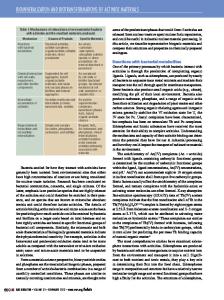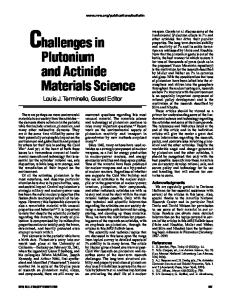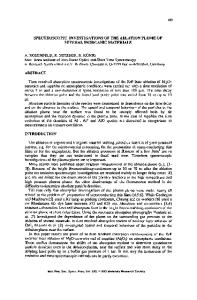Spectroscopic characterization of actinide materials
- PDF / 921,902 Bytes
- 9 Pages / 585 x 783 pts Page_size
- 12 Downloads / 358 Views
Introduction Despite extensive efforts over many decades, much remains to be discovered about the electronic structure of actinide materials. The standard models of condensed-matter physics are often inadequate to describe the peculiar behavior associated with the presence of 5f valence electrons, and while experimental evidence questioning basic assumptions accumulates, novel theoretical paradigms are emerging. The complexity of actinides is largely due to the instability of narrow-band 5f states that can be driven toward either localization or itinerancy by small perturbations. Strong correlation phenomena and, in some cases, coexistence of atomic and metallic electron behavior raise formidable obstacles for a comprehensive theoretical approach.1 The low-temperature properties of solids depend on the structure of the open electronic shells of the constituent atoms. The electrons in these shells can either delocalize and form band states or retain localized atomic-like behavior. The spatially extended s and p states always assume a band character, whereas d and f electrons display various degrees of localization in different compounds, ranging from fully localized to highly itinerant band-like situations. In the case of f electrons, strong spin-orbit coupling and the presence of unquenched orbital
degrees of freedom give rise to a rich variety of phenomena involving dipole and higher-order electromagnetic multipole interactions.2 These interactions influence the dynamics of the system and may also drive exotic phase transitions involving hidden (non-dipolar) order parameters, as proposed for NpO2 (Reference 3) and URu2Si2 (Reference 4). Fluctuations of multipolar-order parameters can provide the mediating bosons in exotic superconductors5 or lead to the emergence of novel heavy-fermion states.6 Metallic actinide systems often exhibit unusual properties, suggesting, in some cases, the emergence of new physics beyond the “standard” Landau-Fermi liquid theory, the phenomenological theory commonly used to describe interacting fermion systems. Hybridization between 5f and ligand- or conduction-electron states is responsible for the appearance of valence fluctuations, damping of the magnetic dynamics, stabilization of heavy-Fermi-liquid ground states or unconventional superconductivity.7–10 In this article, we review selected examples that illustrate the challenges and successes of several spectroscopy techniques applied to the characterization of actinide materials. In particular, we focus on two classes of materials, namely actinide metals/ alloys and actinide dioxides, which are particularly important
R. Caciuffo, Actinide Research Department, Institute for Transuranium Elements, Karlsruhe, Germany; [email protected] E.C. Buck, Pacific Northwest National Laboratory, Richland, WA 99354, USA; [email protected] D.L. Clark, Los Alamos National Laboratory, NM 87545, USA; [email protected] G. van der Laan, Diamond Light Source, UK; [email protected]
MRS BULLETIN • VOLUME 35 • NOVEMBER 2010 • www.mrs
Data Loading...











